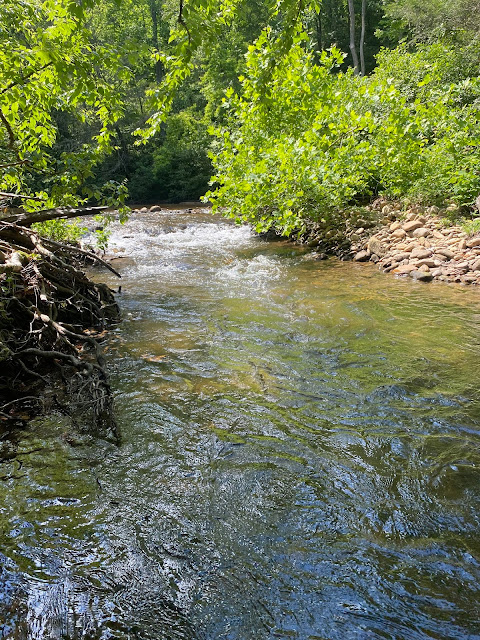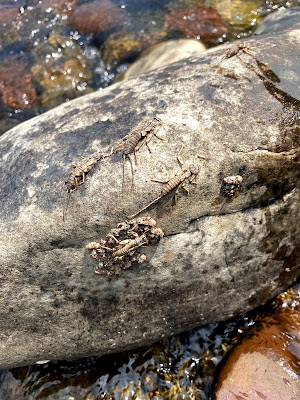Not all water is created equal
What do you think about when you show up to a new fly fishing spot?
If you have done your homework by checking flows, water/air temps, and the (dreaded) wind, you're off to a great start.
So, where do fish live? Why do they live there? How can our (hopefully) well presented flies draw their gaze and a potential take?
The answers to these questions are not always straightforward, but constantly fishing "higher quality water," will increase your hookup rate.
How would you approach this piece of water? I was walking upstream on a creek in North Carolina this summer when I found this nice little area.
Although there are sticks on the left my first cast was just along the edge. Why? The path of least resistance. If a trout is holding there it will only see my flies, which is what I always want. Spooking fish is so common and sometimes we don't even know that we've spooked them. We just think there aren't any fish in that spot. If you are fishing a river that you know holds fish and you know you're in a great spot, there are fish there.
Being an accurate caster with a nymph rig is just as important as when you toss a dry fly.
Now, since this run wasn't very deep I also made a few casts right in the middle of the run. I noticed that my flies weren't getting down quite were I wanted them due to the speed of the water, so I added one more weight and cast another few feet upstream into the fastest water. That turned out to be the difference and I caught this nice, unsuspecting brown.
Another great casting area is on the right side away from the main current. I started toward the tail out and then took several steps forward before casting again. I pulled a little brookie out of there and was happy with how I fished this particular piece of water.
Trout are opportunistic feeders as well so remember that if you are fishing a solid piece of water and aren't getting takes, make adjustments. Make sure you flies are getting down. Make sure you didn't just make a good cast into a prime area, but a great one. Lastly, if you find one fish, you'll probably find more.
How would you fish around these boulders? I was on the Roaring Fork with my buddy Scott in July and we came across this beautiful area.
I love fishing areas like this because the fish have plenty of cover. The white water and boulders create little runs and the fish are usually down deep enough where the water is about half the speed as it is on the surface. I also like to cast upstream and wait for the take. If I don't get one, I always add more weight or change my depth a foot or so.
Be very stealthy when fishing boulders, but be careful. I have definitely had to dry myself off and drain out my waders after fishing an area like this.
Boulders also mean Caddis and Stoneflies so I like to fish a Peeping Caddis or a Pat's Rubber Legs (or both) when fishing water like this. The fish know the Caddis are in and around the rocks and they also know that the Stoneflies climb up on the rocks to shed their exoskeletons before they become duns.
If you even see THIS on the river, put on a Stonefly. When fishing stones, make sure you get them down. I know that might go without saying, but I try to visualize my imitation bouncing along the bottom of the river or swirling in pocket water/around boulders. A guide once told me to let my flies "soak" in those areas. He's not wrong.
When I fished this next area I wanted to make my first cast count. I cast to the left of the two rocks in the middle and let my flies drift down that little run. As soon as my flies hit the little pool below the rocks this brown trout hammered my stonefly imitation.
It was a high quality piece of water and I had seen Stonefly shucks on the water earlier in the day so it all came together and my friend Isaac got this cool shot.
Not all water is created equal. There are areas that fish prefer to hold and areas you won't find many at all.
Sometimes I watch other people fish and I often see nymph fisherman stay in the same spot for 30 minutes or more. If you are fishing a huge pool I can see that, but if you're not, why not move?
Fishing many different spots in a day isn't only fun because no two pieces of water are the same, but you'll also increase your opportunity of hooking more fish if you hit as many different spots as you can in one day.
I will usually hike downstream and fish my way back up for three reasons:
1. I know I won't be spooking fish because I'm hiking upstream.
2. With every step I am working my way back to the car.
3. Exercise!
Also, check my out website: www.mayflymusings.com and follow me on Instagram @mayflymusings
Until next time, stay safe and tight lines.









Comments
Post a Comment